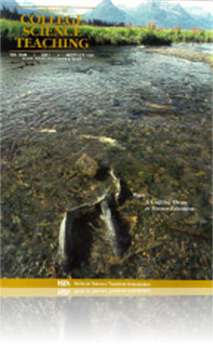All Journal of College Science Teaching resources
Journal Article
Not only are stories captivating, they make it easier to learn and recall facts, figures, and equations. Stories tell us who we are as a people—the problems we face, the values we cherish, the barriers we must surmount....
Journal Article
This article describes a course in experimental science for preservice elementary education students. Through “directed discovery,” students collaborate in developing and executing a plan to investigate water as a common thread in biology, chemis...
Journal Article
In this column the leadership of SCST shares its views with JCST readers. In this month’s issue the focus is on the first SCST goal: Improvement in the teaching of college science courses via interdisciplinary interactions among teachers of college...
Journal Article
In over 18 years of operation, the Michigan State University’s “Spartan Speakers Program” has provided over 346 quality seminars, discussions, and workshops at over 40 four-year and community colleges throughout the state of Michigan. This arti...
Journal Article
This article describes a new teaching strategy employed in a senior-level microbiology course where up to 25 students are introduced to and conduct semester-long original research projects. The paper presents examples of several student projects. Ove...
Journal Article
Using the inquiry method, nonscience majors in Portland State University’s Natural Science Inquiry classes complete student-directed projects, individually and in groups, that tackle scientific, ethical, political, and social issues. By observing, ...
Journal Article
The phenomenon of complementation is not only one of the most important, but it is also one of the most challenging concepts for undergraduate genetics students to grasp. Complementation occurs when parents with the same mutant trait have offspring t...
Journal Article
In clinical laboratories, molecular methods of DNA analysis such as the polymerase chain reaction (PCR) are used to identify fungal and bacterial pathogens, parasites, and important viruses. This laboratory will fit into many teaching settings to sho...
Journal Article
The aim of this study is to determine what students' conceptions of a chemical are as they graduate with degrees in chemistry. With the knowledge of what preconceptions students are bringing into the classroom, educators must alter their plan of stud...
Journal Article
Teaching in ways that help students understand the nature of science and how to use scientific reasoning patterns have long been central goals of science education. This article attempts to explicate the basic pattern of scientific reasoning, show ho...
Journal Article
Ronald Giere has created a novel and effective approach for teaching general education science courses. His textbook provides students with an opportunity to understand the sciences in the context they will typically encounter the material—in the p...
Journal Article
In this column the leadership of the Society for College Science Teachers (SCST) shares its views with JCST readers. In this month’s issue the new president focuses on where the Society goes from here in addressing the changes that have taken place...
Journal Article
The abstract writing assignments described in this article focus on a central theme and require the students to apply, rather than summarize, course material. This method has the additional benefit of making connections between different course topic...




